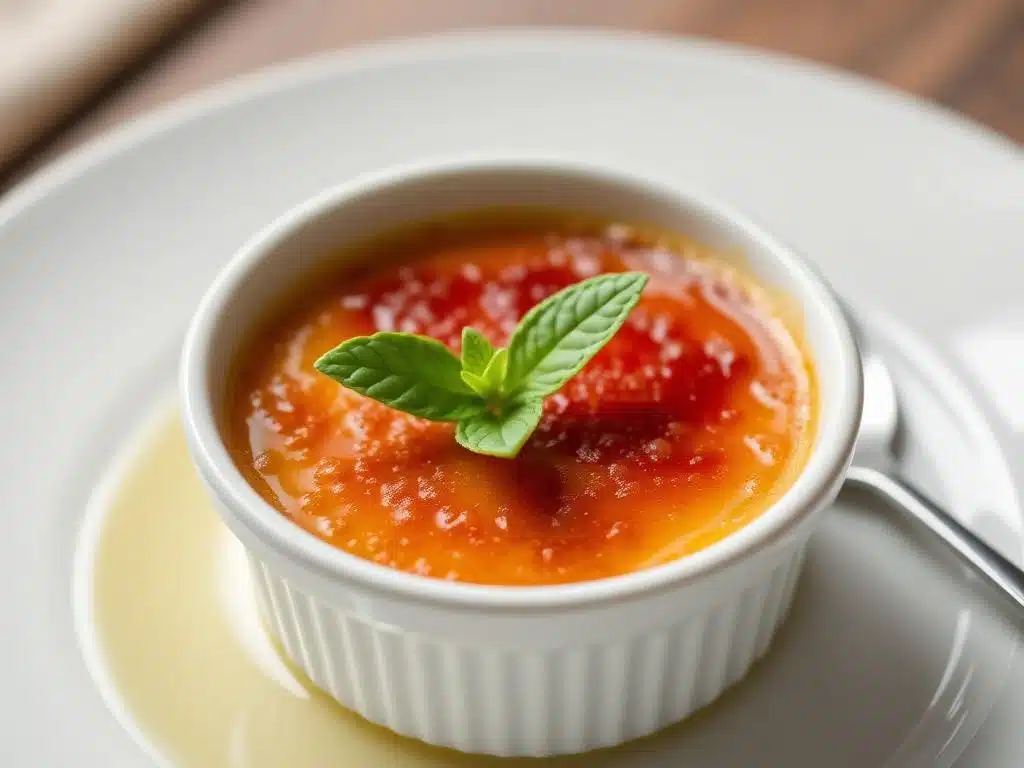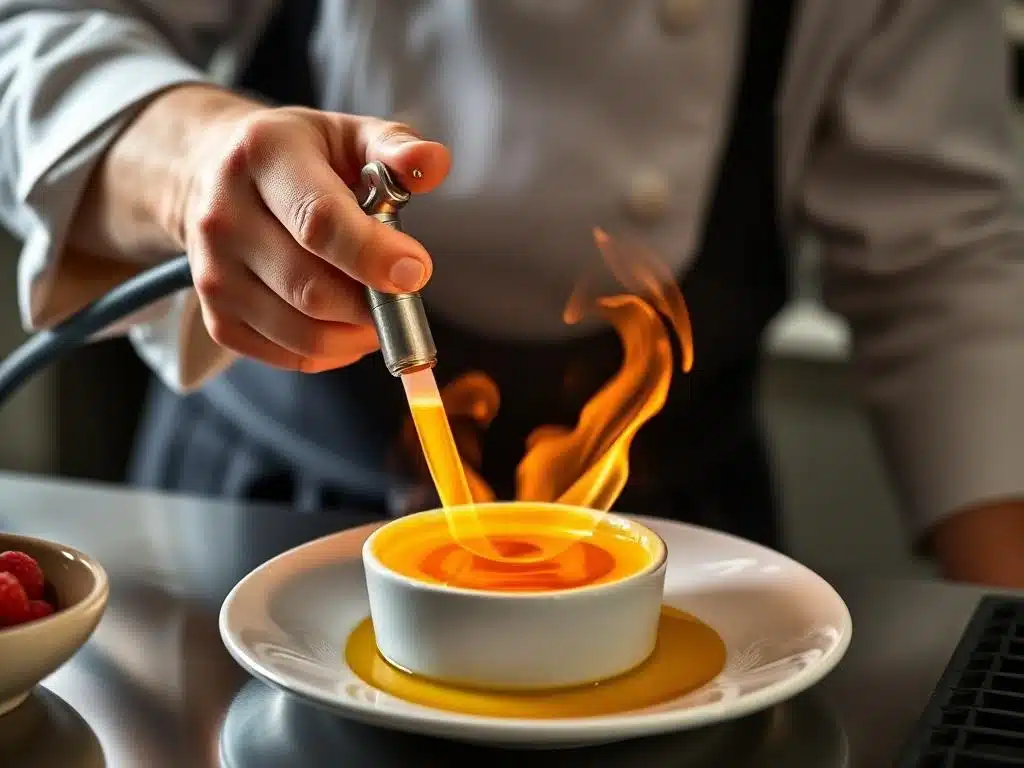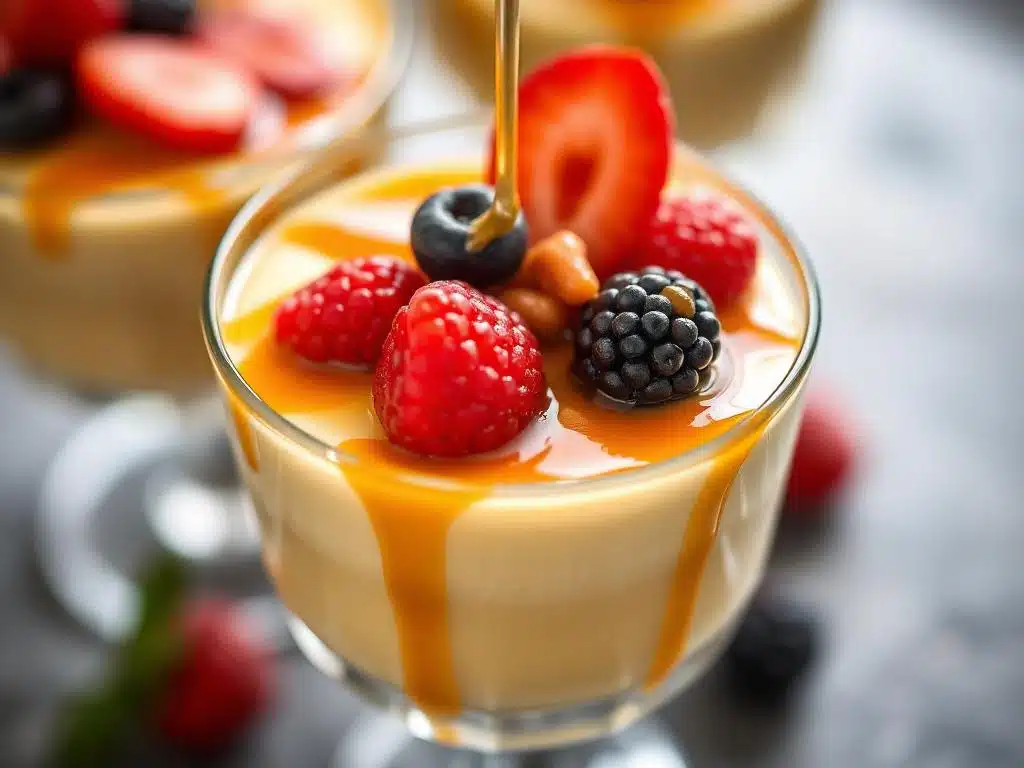When it comes to desserts, few things can rival the creamy, dreamy textures of crème brûlée and custard. Both are beloved in the culinary world, yet they have distinct characteristics that set them apart. In this article, we’ll dive deep into the differences between these two delightful treats, exploring their ingredients, preparation methods, and even their nutritional profiles. Whether you’re a dessert aficionado or just curious about these sweet sensations, you’re in for a treat!
Introduction to Crème Brûlée and Custard
Overview of Crème Brûlée and Custard
At first glance, crème brûlée and custard might seem like two peas in a pod. After all, they both share a rich, creamy texture and are often made with similar ingredients. However, the nuances in their preparation and presentation make them unique.
Custard is a versatile dessert that can be served in various forms, from a simple pudding to a more complex pastry cream. On the other hand, crème brûlée is a specific type of custard that’s known for its signature caramelized sugar topping. This delightful contrast between the creamy base and the crunchy top is what makes crème brûlée a standout dessert.
Importance of Understanding the Differences
Understanding the differences between crème brûlée and custard is essential for anyone who loves to cook or bake. Knowing how to distinguish between these two desserts can help you choose the right recipe for your occasion. Whether you’re hosting a dinner party or simply indulging in a sweet treat at home, being informed can elevate your dessert game.
Purpose of the Article
The purpose of this article is to provide a comprehensive guide to the differences between crème brûlée and custard. We’ll explore their definitions, ingredients, cooking methods, and even their nutritional values. By the end of this article, you’ll have a clear understanding of what sets these two desserts apart, and you might even feel inspired to whip up a batch of your own!
So, let’s get started on this delicious journey into the world of crème brûlée and custard!
What is Custard?
Definition of Custard
Custard is a rich, creamy dessert made primarily from eggs and milk or cream. It’s known for its smooth texture and can be served in various forms, from a simple pudding to a more elaborate pastry cream. The beauty of custard lies in its versatility; it can be enjoyed on its own or used as a filling for pastries, tarts, and other desserts.
Types of Custard
When it comes to custard, there are two main types: baked custard and stirred custard. Each type has its unique characteristics and uses.
Baked Custard
Baked custard is typically prepared in a dish and cooked in the oven. This method allows the custard to set firmly, resulting in a smooth, creamy texture. Classic examples of baked custard include flan and crème caramel. The gentle heat of the oven helps to create a delicate balance of flavors, making it a favorite among dessert lovers.
Stirred Custard
On the other hand, stirred custard is cooked on the stovetop, where the mixture is constantly stirred until it thickens. This type of custard is often used as a base for sauces or as a filling for pastries. A popular example of stirred custard is pastry cream, which is commonly used in desserts like éclairs and fruit tarts.
Ingredients Used in Custard
The ingredients for custard are quite simple, yet they come together to create a delightful treat. Here’s a closer look at the key components.
Eggs
Eggs are the star ingredient in custard. They provide the necessary structure and richness, giving the dessert its creamy texture. The proteins in the eggs coagulate during cooking, helping the custard to set.
Milk and Cream
Milk and cream are essential for achieving that luscious, velvety consistency. While whole milk can be used, many recipes call for heavy cream or a combination of both to enhance the richness of the custard.
Sweeteners
To sweeten the custard, granulated sugar is typically used. However, other sweeteners like honey or maple syrup can also be incorporated for a unique flavor twist.
Cooking Methods for Custard
The cooking method you choose can significantly impact the final product. Here are the two primary methods for preparing custard.
Stovetop
When making stirred custard, the mixture is cooked over low heat on the stovetop. It’s crucial to stir continuously to prevent the eggs from scrambling. Once the custard thickens to the desired consistency, it’s removed from the heat and allowed to cool.
Oven
For baked custard, the mixture is poured into a baking dish and cooked in a water bath. This gentle cooking method helps to ensure even heat distribution, resulting in a smooth, creamy texture. The custard is typically baked until it’s just set, allowing it to maintain its delicate consistency.
Now that we’ve explored the world of custard, it’s time to turn our attention to crème brûlée and discover what makes this dessert so special!
What is Crème Brûlée?

Definition of Crème Brûlée
Crème brûlée, often referred to as “burnt cream,” is a classic French dessert that features a rich custard base topped with a layer of caramelized sugar. The contrast between the smooth, creamy custard and the crunchy, caramelized topping is what makes crème brûlée a favorite among dessert enthusiasts. This delightful treat is typically served in individual ramekins, making it perfect for elegant dinner parties or special occasions.
Ingredients Used in Crème Brûlée
The ingredients for crème brûlée are quite similar to those used in traditional custard, but with a few key differences that enhance its unique flavor and texture.
Eggs
Like custard, eggs are a crucial component of crème brûlée. They provide richness and help the custard set during baking. The yolks are particularly important, as they contribute to the dessert’s velvety texture and golden color.
Cream
While custard can be made with milk, crème brûlée typically uses heavy cream. This choice adds a luxurious richness that elevates the dessert to a whole new level. The cream is often infused with flavors like vanilla, which enhances the overall taste.
Sugar
Granulated sugar is used in two ways in crème brûlée: first, to sweeten the custard base, and second, to create the signature caramelized topping. The sugar is sprinkled on top of the cooled custard and then caramelized using a kitchen torch or broiler, creating that delightful crunchy layer.
Cooking Method for Crème Brûlée
The preparation of crème brûlée involves a few specific steps that set it apart from other custards.
Baking in a Water Bath
To achieve the perfect texture, crème brûlée is baked in a water bath, also known as a bain-marie. This method involves placing the ramekins filled with custard into a larger baking dish filled with hot water. The water bath helps to regulate the temperature, ensuring that the custard cooks evenly and gently. This technique is essential for preventing the custard from curdling and achieving that silky-smooth consistency.
The Caramelized Sugar Topping
The pièce de résistance of crème brûlée is undoubtedly the caramelized sugar topping. After the custard has cooled and set, a thin layer of sugar is sprinkled on top. Using a kitchen torch, the sugar is melted and caramelized until it forms a hard, glass-like crust. This crunchy layer adds a delightful contrast to the creamy custard beneath, making each bite a perfect balance of textures.
With a solid understanding of what crème brûlée is, we can now explore the key differences between crème brûlée and custard. Let’s dive into the details!
Key Differences Between Crème Brûlée and Custard
When comparing crème brûlée and custard, it’s essential to highlight the key differences that make each dessert unique. While they share some similarities, their textures, flavors, preparation techniques, and presentation styles set them apart. Let’s break down these differences in detail.
Texture and Consistency
One of the most noticeable differences between crème brûlée and custard is their texture.
- Custard: Generally, custard has a smooth and creamy consistency, which can vary depending on the type. Baked custards tend to be firmer, while stirred custards are often more fluid and pourable. The texture can also be influenced by the cooking method and the ratio of eggs to liquid.
- Crème Brûlée: In contrast, crème brûlée boasts a velvety, rich texture that is slightly thicker than most custards. The baking process in a water bath helps achieve this luxurious mouthfeel, while the caramelized sugar topping adds a delightful crunch that contrasts beautifully with the creamy base.
Flavor Profiles
The flavor profiles of these two desserts also differ significantly.
- Custard: The flavor of custard is primarily influenced by the ingredients used. It can be flavored with vanilla, chocolate, or even fruit purees, allowing for a wide range of taste experiences. The sweetness level can also vary based on personal preference and the recipe.
- Crème Brûlée: Crème brûlée typically has a more pronounced vanilla flavor, as it often includes vanilla beans or extract in the cream. The caramelized sugar topping adds a unique sweetness and a hint of bitterness, creating a complex flavor profile that is both rich and satisfying.
Preparation Techniques
The preparation methods for crème brûlée and custard are distinct, which contributes to their differences.
- Custard: Making custard can be relatively straightforward, especially for stirred varieties. The mixture is cooked on the stovetop, requiring constant stirring to prevent curdling. Baked custards are also simple to prepare but may require more attention to ensure even cooking.
- Crème Brûlée: The preparation of crème brûlée is a bit more involved. It requires baking in a water bath, which can be a bit tricky for novice bakers. Additionally, the caramelization of the sugar topping requires a kitchen torch or broiler, adding an extra step to the process.
Serving Styles
The way these desserts are served also highlights their differences.
- Custard: Custard can be served in various forms, from individual cups to larger dishes. It can be enjoyed warm or chilled, depending on the type and personal preference. Often, it’s garnished with fruit, whipped cream, or chocolate shavings.
- Crème Brûlée: Crème brûlée is typically served in individual ramekins, which adds an elegant touch to any dessert table. The signature caramelized sugar topping is usually left unadorned, allowing the beautiful contrast between the creamy custard and the crunchy top to shine.
Presentation and Garnishing
Finally, the presentation of these desserts can vary significantly.
- Custard: Depending on the type, custard can be presented in a variety of ways. It may be poured into a bowl, served in a tart shell, or layered in a parfait glass. Garnishes can include fresh fruit, chocolate, or even a dusting of cocoa powder.
- Crème Brûlée: The presentation of crème brûlée is often more refined. The ramekins are typically served as-is, showcasing the glossy custard and the shiny, caramelized sugar crust. A simple garnish of fresh berries or a sprig of mint can enhance the visual appeal without overshadowing the dessert itself.
With a clear understanding of the key differences between crème brûlée and custard, let’s move on to explore their nutritional comparisons. This will help you make informed choices when indulging in these delightful desserts!
When comparing Crème Brûlée and custard, their subtle differences often boil down to texture and preparation. For instance, the silky texture of custard comes from its delicate balance of eggs and cream, much like the luscious filling in desserts such as cheesecake filling. Meanwhile, the caramelized sugar topping of Crème Brûlée offers a contrast to its creamy interior, akin to the crispy yet indulgent texture that defines air fryer nachos. If you’re fascinated by dessert innovations, you might also enjoy exploring unique ideas like the viral crookie recipe, which combines unexpected elements into a delightful treat.
Nutritional Comparison
When it comes to desserts, understanding the nutritional aspects can help you make informed choices. Both crème brûlée and custard have their unique nutritional profiles, influenced by their ingredients and preparation methods. Let’s take a closer look at the caloric content, macronutrient breakdown, and health considerations for each dessert.
Caloric Content
The caloric content of crème brûlée and custard can vary significantly based on the specific recipe and portion size.
- Custard: A typical serving of custard (about 1/2 cup) can range from 150 to 250 calories, depending on the ingredients used. For instance, a custard made with whole milk and fewer eggs will generally have fewer calories than one made with heavy cream and multiple egg yolks.
- Crème Brûlée: On the other hand, a serving of crème brûlée (also about 1/2 cup) tends to be higher in calories, often ranging from 300 to 400 calories. This increase is primarily due to the use of heavy cream and the added sugar for the caramelized topping.
Macronutrient Breakdown
The macronutrient composition of these desserts can also differ, particularly in terms of fat, carbohydrates, and protein.
- Custard: Generally, custard is lower in fat, especially if made with milk instead of cream. A typical serving may contain around 5-10 grams of fat, 20-30 grams of carbohydrates, and 4-6 grams of protein. The protein content comes mainly from the eggs, which are a significant source of high-quality protein.
- Crème Brûlée: In contrast, crème brûlée is richer in fat due to the heavy cream, often containing 15-25 grams of fat per serving. The carbohydrate content is similar, usually around 25-30 grams, primarily from the sugar. The protein content is comparable to that of custard, with about 4-6 grams per serving.
Health Considerations
While both crème brûlée and custard can be enjoyed as occasional treats, it’s essential to consider their nutritional profiles in the context of a balanced diet.
- Custard: Because custard can be made with lower-fat ingredients, it may be a better option for those looking to reduce their calorie intake. Additionally, it can be easily adapted to include healthier ingredients, such as using alternative sweeteners or incorporating fruit for added nutrients.
- Crème Brûlée: While crème brûlée is undeniably delicious, its higher fat and calorie content make it a more indulgent choice. It’s best enjoyed in moderation, especially for those watching their caloric intake. However, the rich flavor and unique texture can make it a worthwhile treat for special occasions.
Popular Variations of Custard and Crème Brûlée

Both custard and crème brûlée have inspired a variety of delicious variations that cater to different tastes and preferences. Let’s take a closer look at some popular adaptations of each dessert, showcasing their versatility and creativity in the culinary world.
Variations of Custard
Custard is a versatile dessert that can be transformed in numerous ways. Here are a couple of popular variations:
Pastry Cream
Pastry cream, or crème pâtissière, is a thick custard used as a filling for various pastries, such as éclairs, tarts, and cream puffs. It’s made by cooking milk, sugar, and egg yolks together until thickened, then cooling it down. Often flavored with vanilla, chocolate, or fruit purees, pastry cream adds a rich and creamy element to desserts, making it a favorite among pastry chefs.
Flan
Flan is a popular custard dessert in many cultures, particularly in Latin America and Spain. It features a smooth custard base topped with a layer of caramel sauce. The preparation is similar to that of baked custard, but the addition of caramel gives it a distinct flavor and appearance. Flan is often served chilled, making it a refreshing treat on warm days.
Variations of Crème Brûlée
Crème brûlée has also inspired a range of creative variations that add unique flavors and twists to the classic recipe. Here are a couple of noteworthy adaptations:
Flavored Crème Brûlée
While traditional crème brûlée is often flavored with vanilla, many chefs have experimented with different flavors to create exciting variations. Some popular options include:
- Chocolate Crème Brûlée: Rich chocolate is incorporated into the custard base, creating a decadent dessert that chocolate lovers adore.
- Coffee Crème Brûlée: Brewed coffee or espresso is added to the custard, infusing it with a bold coffee flavor that pairs beautifully with the caramelized sugar topping.
- Fruit-Flavored Crème Brûlée: Pureed fruits, such as raspberry or passion fruit, can be mixed into the custard for a refreshing twist.
Savory Crème Brûlée
For those looking to explore beyond sweet desserts, savory crème brûlée variations have gained popularity. These unique adaptations often feature ingredients like cheese, herbs, or even vegetables. A savory crème brûlée can serve as an elegant appetizer or side dish, showcasing the versatility of this classic dessert.
With these delightful variations in mind, it’s clear that both custard and crème brûlée can be adapted to suit a wide range of tastes and occasions. Now, let’s address some frequently asked questions about these two beloved desserts!
FAQs
As we delve deeper into the world of crème brûlée and custard, you might have some questions about these delightful desserts. Here are some frequently asked questions that can help clarify any uncertainties you may have.
1.What is the main ingredient in custard?
The main ingredient in custard is eggs, which provide richness and help the mixture set during cooking. The combination of eggs with milk or cream creates the smooth, creamy texture that custard is known for. Depending on the recipe, additional ingredients like sugar and flavorings can also be included.
2.Can crème brûlée be made without eggs?
While traditional crème brûlée relies on eggs for its rich texture and structure, it is possible to make egg-free versions using alternatives like silken tofu or commercial egg replacers. However, the flavor and texture may differ from the classic recipe. If you’re looking for a vegan option, consider using coconut cream or cashew cream as a base.
3.How do you store crème brûlée?
To store crème brûlée, cover the ramekins with plastic wrap and refrigerate them. It’s best to add the caramelized sugar topping just before serving to maintain its crunchy texture. If you have leftover crème brûlée, it can be stored in the fridge for up to 2-3 days, but the quality may diminish over time.
4.Is custard the same as pudding?
While custard and pudding share similarities, they are not the same. The primary difference lies in the thickening agents used. Custard is thickened with eggs, while pudding is typically thickened with cornstarch. This results in a different texture and flavor profile. Additionally, custard is often cooked gently, while pudding is usually cooked more vigorously.
5.Can you make crème brûlée without a torch?
Yes, you can make crème brûlée without a kitchen torch! If you don’t have a torch, you can use your oven’s broiler. Simply sprinkle sugar on top of the cooled custard and place it under the broiler for a few minutes, watching closely to prevent burning. This method will also create the desired caramelized sugar topping, although it may not achieve the same level of precision as a torch.
Conclusion
In this article, we’ve explored the delightful world of crème brûlée and custard, uncovering the key differences that make each dessert unique. From their textures and flavor profiles to their preparation techniques and serving styles, it’s clear that while they share some similarities, they each have their own distinct characteristics.
Custard is a versatile dessert that can be enjoyed in various forms, whether baked or stirred, and can be flavored in countless ways. On the other hand, crème brûlée stands out with its rich custard base and signature caramelized sugar topping, offering a luxurious treat that’s perfect for special occasions.
Final Thoughts on Choosing Between Crème Brûlée and Custard
Ultimately, the choice between crème brûlée and custard comes down to personal preference and the occasion. If you’re looking for a classic, elegant dessert that impresses, crème brûlée is the way to go. However, if you prefer a more versatile option that can be adapted to suit various flavors and presentations, custard is an excellent choice.
No matter which dessert you choose, both crème brûlée and custard are sure to delight your taste buds and leave a lasting impression. So, whether you’re whipping up a batch at home or indulging in a restaurant treat, enjoy the creamy goodness of these beloved desserts!

